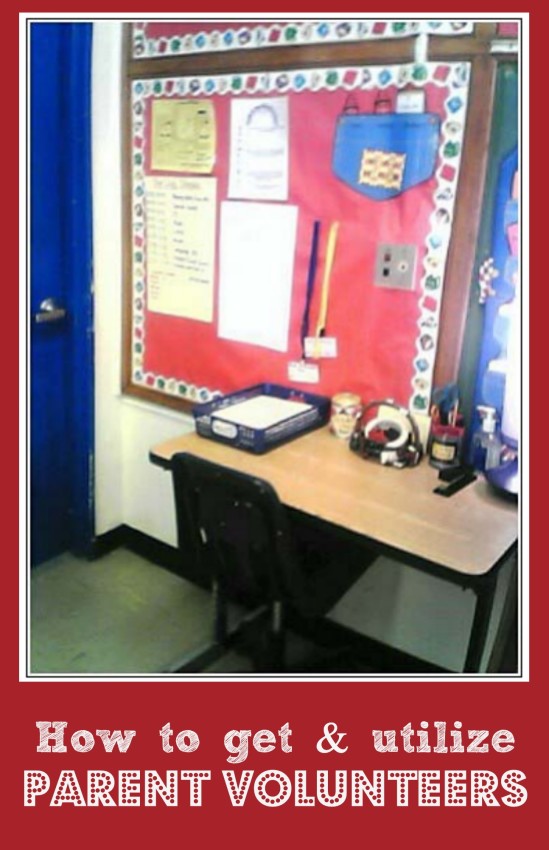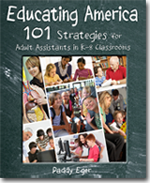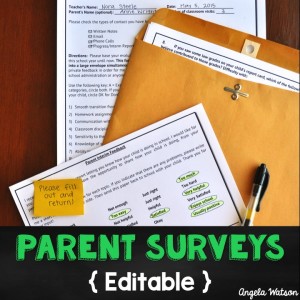Having multiple adults in the classroom can be a fantastic experience for everyone involved once clear expectations and open communication are established. This page will help you discover strategies for making the most of volunteers in your classroom and making parents feel welcome and valuable.

Creating a workable system for parent volunteers
I’ve worked in schools with tons of parent volunteers and those with very few. As a new teacher, I preferred to just be left alone, but over time, I came to really appreciate having students’ family members volunteer in the classroom. I realized that the main reason why I disliked having classroom volunteers at first was because it always seemed like training someone else was more work for me than just doing everything myself! Once I set up a self-running system for parents to contribute to the classroom, I realized that parent volunteers could actually save me time.
One of the best tips I can offer is to have a designated space in your classroom for parent volunteers to work. Depending on the size of your room, this may not be an area used exclusively by them, but it should be a place where they can feel comfortable and have access to the materials they need.

The photo to the left was my “volunteer table” one school year. I kept a list of things I needed done on top of the basket you see on the left. Anytime I thought of a task that a parent volunteer could do, I jotted it down there, and put asterisks next to the most important tasks. This way volunteers could choose things that they enjoyed doing and were good at, and could get started immediately without having to interrupt instruction to find out what I needed. Volunteers crossed off each item as it was completed and put the finished product(s) on my desk so I knew they were done.
The list was on top of the basket; all the papers and materials for the projects were underneath in the basket. The parent table also held scissors, pens, glue, a stapler, tape, and anything else that volunteers would need.
When volunteers entered our classroom, I taught the kids to smile and wave and then keep working. The volunteers knew they could go straight to their area and find lots of things to work on. During a break in instruction, I’d go over to say hi and check on them, answering any questions that might have come up. This was a great arrangement for volunteers who wanted to help in the classroom, but weren’t comfortable working directly with students (or weren’t allowed to per school regulations.)
Choosing tasks for volunteers
What type of tasks did these volunteers complete? Typically I’d send home a survey asking volunteers what type of things they’d like to do so I could make sure I had appropriate suggestions for them. Some completed very basic tasks, such as cutting out laminated items, putting up and taking down bulletin boards, making photocopies, and sharpening pencils. Others worked on things like making flashcards, constructing center materials, researching information for field trips, updating computer software and doing tech support, organizing manipulatives, leveling books for the class library, and gathering materials for science experiments.
Valuable ways for volunteers and adult assistants work with students
Typically I prefer to have assistants work in the hallway or an empty classroom with students. This prevents the kids from being distracted and the noise level from rising too high. In situations in which I couldn’t arrange this, I would try to set up our daily schedule so that I wasn’t instructing while the para or volunteer was in the room. When the whole class is doing the same thing at the same time, having another adult in the room pulling kids away from that situation feels disruptive. But when students are working in centers or small groups or projects, the movement and “buzz” fit right in.
Sometimes I would have adult assistants work with below-grade-level students. This might involve flashcard drills, teaching remedial lessons, going over previously completed assignments, etc. Often the best (and most enjoyable) use of the volunteer’s time was simply reading with students.
I like to keep the role of the volunteer or aide as flexible as possible, and base the structure and tasks on the needs and strengths of both the adult and the child(ren) he or she is working with. I’ve found that setting up a month-by-month plan often works best: discuss the goals for the upcoming weeks, then meet briefly to evaluate how things are going and the direction in which to go next.
Training classroom aides and volunteers
It’s important to have some one-on-one time with assistants prior to their first time coming in the classroom. Introduce yourself, show them around the room, give them a copy of your schedule, and answer any questions they might have. After their first time in your classroom, try to find a few minutes to meet with them again and talk about how it went. I like to check in with volunteers on a regular basis to talk about what’s working and what’s not, and see if there is anything I can do to support them.
Advice from an expert on adult assistants in the classroom

Paddy Eger’s new book Educating America: 101 Strategies for Adult Assistants in K-8 Classroomsis the best resource I’ve seen on this topic. It’s based on the principle that one teacher cannot (and should not) meet the needs of an entire classroom full of students alone. Community and parent support are needed now more than ever, and school workers as well as corporate and community groups need to know how they can be most useful in the classroom.
One of the most remarkable things about this book is that its advice applies equally well to teachers, parents, volunteers, para-professionals, and other classroom assistants (the first part of the book contains more general strategies, with separate chapters written “mostly” for each type of classroom worker.) Educating America tackles tricky topics from setting expectations to monitoring student progress. The advice goes far beyond common sense stuff and provides genuinely useful tips that you can tell are effective in real classrooms.
Paddy provides realistic examples of how classroom assistants can be truly valuable in helping meet the needs of students, explaining in plain English how they can use questioning strategies with kids and help them develop thinking skills. There is an entire chapter on how assistants should handle misbehavior, and the appendix includes helpful checklists and planning worksheets.
I think this book meets a big need right now in providing practical resources and advice on incorporating adult assistants in the classroom. Paddy’s website also has full-size worksheets that can be downloaded, with new resources added weekly. If you are looking for tips from an educator who’s been there, I highly recommend Paddy’s book and website!
How to get parents to volunteer in the classroom

I like to send home a Parent Volunteer Survey to communicate ways parents can help out with classroom needs. You can send a survey like this home during the first week of school, whenever a new student transfers into your class, and anytime a parent asks how they can be involved in their child’s schooling. You might also send the form home at the start of the second semester to remind parents of various opportunities and accommodate their changing schedules.
Often when parents say, “Just let me know if you need anything—I’d love to help,” we don’t have a ready response for them. Now you can reply, “Great—just fill out this quick survey and I’ll get back to you right away!” This survey will help you explain alternative ways busy parents can offer their time and resources, tap into parent resources you might not have known about, and communicate to parents that they are your partners and allies. I have made an editable version of my parent surveys available on TeachersPayTeachers and a version of the parent surveys in Spanish as well.

Angela Watson
Founder and Writer
Sign up to get new Truth for Teachers articles in your inbox
Discussion
OR

Join our
community
of educators
If you are a teacher who is interested in contributing to the Truth for Teachers website, please click here for more information.
















I really enjoyed reading your post. I agree with a lot of the information on this post. Another feature that a lot of teachers are finding helpful is having a volunteer management website to organize their parent volunteers. We give school PTA/PTO/Parent groups free volunteer management websites. It is a very necessary tool when you need to manage a lot of volunteers!
A volunteer website is a wonderful idea to recruit and manage free volunteer services because it allows individuals to be flexable when time allows and they are doing something that will help everyone involved.
I would think that the uses of volunteers is one of the most under-utilized resources used by teachers because it seem easier to “do” and not to “direct”. Takes much more planning to delegate responsibility than to just do everything yourself.